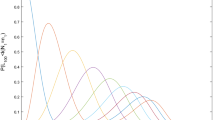Abstract
This paper presents a unified approach for the study of the exact distribution (probability mass function, mean, generating functions) of three types of random variables: (a) variables related to success runs in a sequence of Bernoulli trials (b) scan statistics, i.e. variables enumerating the moving windows in a linearly ordered sequence of binary outcomes (success or failure) which contain prescribed number of successes and (c) success run statistics related to several well known urn models. Our approach is based on a Markov chain imbedding which permits the construction of probability vectors satisfying triangular recurrence relations. The results presented here cover not only the case of identical and independently distributed Bernoulli variables, but the non-identical case as well. An extension to models exhibiting Markov dependence among the successive trials is also discussed in brief.
Similar content being viewed by others
References
Aki, S. (1985). Discrete distributions of orderk on a binary sequence.Ann. Inst. Statist. Math.,37, 205–224.
Aki, S. and Hirano, K. (1988). Some characteristics of the binomial distribution of orderk and related distributions,Statistical Theory and Data Analysis II (ed. K. Matusita), 211–222, North-Holland.
Arratia, R. and Waterman, M. S. (1985). Critical phenomena in sequence matching,Ann. Probab.,13, 1236–1249.
Chao, M. T., Fu, J. C. and Koutras, M. V. (1995). Survey of reliability studies of consecutive-k-out-of-n: F and related systems,IEEE Transactions on Reliability,44, 120–127.
Chryssaphinou, O., Papastavridis, S. and Tsapelas, T. (1993). On the number of overlapping succes runs in a sequence of independent Bernoulli trials,Applications of Fibonacci Numbers,5, 103–112.
Dembo, A. and Karlin, S. (1992). Poisson approximations forr-scan processes,Annals of Applied Probability,2, 329–357.
Feller, W. (1968).An Introduction to Probability Theory and Its Applications, Vol. 1, 3rd ed., Wiley, New York.
Freedman, D. (1965). Bernard Friedman's urn,Ann. Math. Statist. 36, 956–970.
Freidman, B. (1949). A simple urn model,Comm. Pure Appl. Math.,2, 59–70.
Fu, J. C. (1994a). Exact and limiting distributions of the number of successions in a random permutation (preprint).
Fu, J. C. (1994b). Distribution theory of runs and patterns associated with a sequence of multistate trials, Tech. Report, Department of Statistics, University of Manitoba, Canada.
Fu, J. C. and Koutras, M. V. (1994). Distribution theory of runs: A Markov chain approach,J. Amer. Statist. Assoc.,89, 1050–1058.
Gibbons, J. D. (1971).Non Parametric Statistical Inference, McGraw-Hill, New York.
Glaz, J. (1989). Approximations and bounds for the distribution of the scan statistic,J. Amer. Statist. Assoc.,84, 560–566.
Glaz, J. and Naus, J. (1991). Tight bounds and approximations for scan statistic probabilities for discrete data,Annals of Applied Probability 1, 306–318.
Godbole, A. P. (1990a). Specific formulae for some success run distributions,Statist. Probab. Lett.,10, 119–124.
Godbole, A. P. (1990b). On hypergeometric and related distributions of orderk, Comm. Statist. Theory Method,19, 1291–1301.
Godbole, A. P. (1991). Poisson approximations for runs and patterns of rare events,Adv. in Appl. Probab.,23, 851–865.
Goldstein, L. (1990). Poisson approximation in DNA sequence matching,Comm. Statist. Theory Method,19 (11), 4167–4179.
Greenberg, I. (1970). The first occurrence ofn successes inN trials,Technometrics,12, 627–634.
Hirano, K. and Aki, S. (1993). On the number of occurrences of success runs of specified length in a two-state Markov chain,Statistica Sinica,3, 313–320.
Hirano, K., Kuboki, H., Aki, S. and Kuribayashi, A. (1984). Figures of probability density functions in statistics II—discrete univariate case,Comput. Sci. Monographs, No. 20, The Institute of Statistical Mathematics, Tokyo.
Hirano, K., Aki, S., Kashiwagi, N. and Kuboki, H. (1991). On Ling's binomial and negative binomial distributions of orderk, Statist. Probab. Lett.,11, 503–509.
Huntington, R. (1978). Distribution of the minimum number of points in a scanning interval on the line,Stochastic Process Appl.,7, 73–77.
Karlin, S. and MacKen, C. (1991). Some statistical problems in the assessment of inhomogeneities of DNA sequence data,J. Amer. Statist. Assoc.,86, 27–35.
Ling, K. D. (1988). On binomial distributions of orderk, Statist. Probab. Lett.,6, 247–250.
Lou, W. W. (1995). On runs tests for independence of binary longitudinal data using the method of finite Markov chain imbedding, Ph.D. thesis, Deptartment of Community Health, University of Toronto.
Mood, A. M. (1940). The distribution theory of runs,Ann. Math. Statist.,11, 367–392.
Mosteller, F. (1941). Note on an application of runs to quality control charts,Ann. Math. Statist.,12, 228–232.
Naus, J. (1974). Probabilities for a generalized birthday problem,J. Amer. Statist. Assoc.,69, 810–815.
Naus, J. (1982). Approximations for distributions of scan statistics,J. Amer. Statist. Assoc.,77, 177–183.
Panaretos, J. and Xekalaki, E. (1986). On some distributions arising from certain generalized sampling schemes,Comm. Statist. Theory Method,15, 873–891.
Papastavridis, S. G. and Koutras, M. V. (1994). Consecutive-k-out-of-n systems,New Trends in System Reliability Evaluation (ed. K. B. Misra) 228–248, Elsevier, Amsterdam.
Pham, D. (1962),Techniques du Calcul Matriciel, Dunod, Paris.
Philippou, A. N. and Makri, F. S. (1986). Successes, runs and longest runs,Statist. Probab. Lett.,4, 211–215.
Rajarshi, M. B. (1974). Success runs in a two-state Markov chain,J. Appl. Probab.,11, 190–194.
Saperstein, B. (1972). The generalized birthday problem,J. Amer. Statist. Assoc.,67, 425–428.
Saperstein, B. (1973). On the occurrence ofn successes withinN Bernoulli trials,Technometrics,15, 809–818.
Saperstein, B. (1975). Note on a clustering problem,J. Appl. Probab.,12, 629–632.
Schwager, S. (1983). Run probabilities in sequences of Markov dependent trials,J. Amer. Statist. Assoc.,78, 168–175.
Wallenstein, S., Naus, J. and Glaz, J. 1994). Power of the scan statistic in detecting a changed segment in a Bernoulli sequence,Biometrika,81, 595–601.
Wolfowitz, J. (1943). On the theory of runs with some applications to quality control,Ann. Math. Statist.,14, 280–288.
Author information
Authors and Affiliations
About this article
Cite this article
Koutras, M.V., Alexandrou, V.A. Runs, scans and URN model distributions: A unified Markov chain approach. Ann Inst Stat Math 47, 743–766 (1995). https://doi.org/10.1007/BF01856545
Received:
Revised:
Issue Date:
DOI: https://doi.org/10.1007/BF01856545



